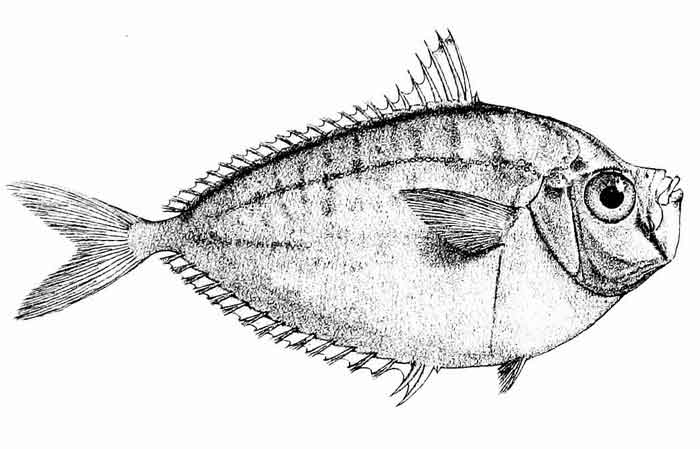
Superregnum: Eukaryota
Cladus: Unikonta
Cladus: Opisthokonta
Cladus: Holozoa
Regnum: Animalia
Subregnum: Eumetazoa
Cladus: Bilateria
Cladus: Nephrozoa
Superphylum: Deuterostomia
Phylum: Chordata
Subphylum: Vertebrata
Infraphylum: Gnathostomata
Megaclassis: Osteichthyes
Superclassis/Classis: Actinopterygii
Classis/Subclassis: Actinopteri
Subclassis/Infraclassis: Neopterygii
Infraclassis: Teleostei
Megacohors: Osteoglossocephalai
Supercohors: Clupeocephala
Cohors: Euteleosteomorpha
Subcohors: Neoteleostei
Infracohors: Eurypterygia
Sectio: Ctenosquamata
Subsectio: Acanthomorphata
Divisio/Superordo: Acanthopterygii
Subdivisio: Percomorphaceae
Series: Eupercaria
Ordo: Chaetodontiformes
Familia: Leiognathidae
Genus: Secutor
Species: S. insidiator
Secutor insidiator, the pugnose ponyfish or barred ponyfish, is a species of ray-finned fish, a ponyfish in the family Leiognathidae.[2] The barred ponyfish's mineralized skeleton contains apatite and the mineralized tissue contains hydroxylapatite.[4] They have bare heads with nuchal spines and their bodies are a distinctive, reflective silver, frequently imitated by fishermen using silver lures. They have a protracted mouth pointing upward and the tip of the maxilla reaches well below the level of the lower margin of the eye. Barred ponyfish feed on zooplankton, including larval fishes and crustaceans.[5] Body depth is twice or slightly more than standard length, which measures 11.3 cm from the tip of the snout to last vertebra.[6] The lateral line ends before the dorsal fin.[7]
Classification/names
Secutor insidiator was first formally described in 1781 as Zeus insidiator by Marcus Elieser Bloch with the type locality given as Surat in India. Henry Weed Fowler named it as the type species of the genus Deveximentum. Some authorities regard the name Secutor to be a synonym of Leiognathus and that the genus should use Fowler’s name.[3] As of November 2023 it is accepted as Deveximentum insidiator (Bloch, 1787) on Fishbase. [8]
Distribution
Secutor insidiator is found in the Indo-Pacific from the Red Sea, Persian Gulf and East Africa In the Indian Ocean to Australia, New Caledonia and Tahiti In the western Pacific Ocean.[2]
Diet
This species is known to feed on phytoplankton, polychaeta (bristle worms), Noctiluca (sea sparkle), and Coscinodiscus.[4]
Predators
The barred ponyfish is known to be eaten by bluefish, Spanish mackerel, saurida, and several species of bonito. It is also used as bait by fishermen to capture larger fish which prey on the barred ponyfish.[4] it has been observed to be consumed by predatory fish such as Barramundi, several species of snapper and species of grouper; however, due to its small size, abundance and minimal defense mechanisms, it is prey for various fish. [9] It is sold for human consumption in markets across Asia, commonly used in the "fried ponyfish" dish.[10]
Habitat
Secutor insidiator lives in shallow waters, close to the bottom and it can occasionally be found in brackish waters.[2]
Human consumption
Barred ponyfish are a delicacy in many parts of Asia such as Pakistan, China, most prevalently consumed throughout the Philippines, most commonly cooked whole, marinated in sauce and fried in oil. This recipe varies, as it is cooked with hot spices in Pakistan. [11] This fish is sold in fish markets across Asia, due to its abundance and lack of resources needed to capture it. [12]
Methods of capture
This fish has been observed to be captured with cast nets by fishermen who are surf fishing, as barred ponyfish have been seen swimming in shoals off the coasts of Singapore.[13] However, commercial fishing boats catch them for sale in large fish markets across Asia. Barred ponyfish are thought to migrate to estuaries with brackish water for purposes such as breeding and/ or feeding, and they can be caught using 'Tamban Rigs' as they are often called by local Singaporean fishermen, which consists of a long 1 metre main line with several small hooks attached to it, anchored by a lead sinker, commonly caught from a bridge or jetty.[14]
References
Alam, S.; Hartmann, S.; Kaymaram, F.; Al-Husaini, M. & Almukhtar, M. (2015). "Secutor insidiator". IUCN Red List of Threatened Species. 2015: e.T166941A57142285. Retrieved 19 November 2020.
Froese, Rainer; Pauly, Daniel (eds.) (2019). "Secutor insidiator" in FishBase. December 2019 version.
Eschmeyer, William N.; Fricke, Ron & van der Laan, Richard (eds.). "Species in the genus Deveximentum". Catalog of Fishes. California Academy of Sciences. Retrieved 19 November 2020.
"Barred ponyfish data - Encyclopedia of Life". eol.org.
"Secutor insidiator, Pugnose ponyfish : fisheries". www.fishbase.de. Retrieved 2020-10-15.
"Barred ponyfish - Encyclopedia of Life". eol.org.
"Secutor insidiator, Pugnose ponyfish : fisheries".
"Deveximentum insidiator (Bloch, 1787)". WoRMS. World Register of Marine Species. Retrieved 2023-11-16.
"Predatory Fish - an overview | ScienceDirect Topics".
"Baby Ponyfish".
"Fried Ponyfish".
"Baby Ponyfish".
"What does cast net mean?".
"Using tamban as bait at bedok jetty".
Retrieved from "http://en.wikipedia.org/"
All text is available under the terms of the GNU Free Documentation License

